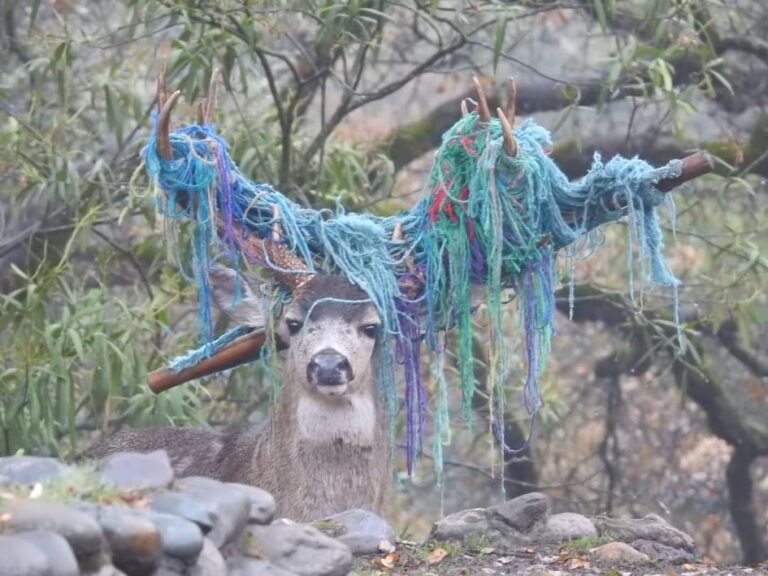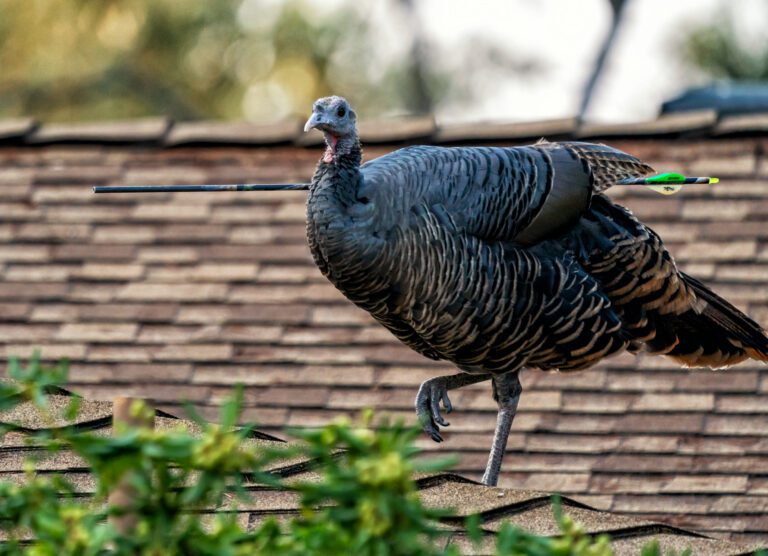Courtesy of California Watchable Wildlife Stories
Early one morning, driving down Hazel Avenue (a major six-lane road), a young buck darted across the road. Three hours later, driving back on the same road, that young buck was dead in the median strip. Driving past the regional mall one day, in the broad expanse of parking lot a few small green boxes pop up to decorate the parking lot, and in one box, a pair of Canada geese tend a nest. In the nearby Starbucks drive-thru, a small flock of wild turkey carefully navigates the busy coffee shop drive-thru. Shopping at Home Depot, a Coopers Hawk is trapped in the gardening section, battering against the skylight.
I am lucky to live near the American River Parkway – Sacramento County had the foresight to preserve about 30 continuous miles of habitat along this tributary of the Sacramento River. However, urban development surrounds this greenbelt and wildlife doesn’t understand why their territory suddenly changes from pristine to pavement.
Most major cities have nothing but fragmented habitat, and urban wildlife has had to learn to survive in small islands of greenery amidst large swaths of human housing, carefully navigating the unnatural territory. Of course, humans and wildlife often collide, and it seldom ends well for the animals.
As a wildlife photographer, I am grateful for this local greenbelt, and as a wildlife rescuer, I am shocked at the lack of concern so many people show for our beautiful wild neighbors. The vast majority of rescues I participate in are due to this combination of lack of suitable habitat and lack of human awareness of the dangers they create. I hope to create a bit more awareness so we can all minimize those inevitable clashes.
Filament (fishing line), lures, and hooks are a major cause of wildlife injury near any waterway, whether it is a river, pond, lake, or ocean, anywhere that people fish, animals get caught up in fishing gear. Discarded fishing line causes death or dismemberment to many animals, especially waterfowl. And if hooks are involved, there is even greater risk of injury. We’ve responded to SO many cases of birds (geese, ducks, cormorants, cranes, herons, egrets, sandpipers, gulls, the list goes on and on) either hanging from trees, or legs wrapped up in line, or hooks down their gullets, there is no end to the injuries from fishing gear. When I walk the river (almost daily), I come off the river with my pockets stuffed with discarded line during fishing season, sometimes with hooks still attached.
In one recent rescue, we had multiple calls and attempts to capture a Great Blue Heron that had two treble hooks caught in him, attached by fishing line. The first hook was in the corner of his mouth, and then the line crossed his neck with the 2nd hook stuck in his lower neck. He was unable to extend his neck to eat or drink, and could not fly well because of this neck restriction. However, he was still flighted enough that no one was able to catch him with hand nets. We finally captured him with a net gun, after about ten days of limited food and water, and were able to work with a veterinary technician at a rehab facility to remove the hooks and patch him up. After a few days on antibiotics and fluids, he was released back to his home. Not all such tales have such a happy ending.
Many animals, especially shorebirds, lose a leg to fishing line. Some lose their life – calls for birds hung up in trees are common, and we can’t always get up into the tree, so the bird dies a slow hard death. I actually had to take a break from writing this article to go try to help rescue a Robin hung upside down in a tree – unfortunately, there was no way to retrieve this specific bird, and he died after a few days hanging in the tree. I’ve captured geese that were hobbled in fishing line – and sadly, been unable to capture just as many. Those that we can’t capture will either lose their leg/foot or lose their life.
Earlier this spring, we tracked a Sandhill Crane for weeks that lost a leg to fishing line. For the first couple of weeks its severed limb was still attached by the filament to the top part of the leg – and when it flew, that severed limb dangled by the line, making it even more awkward for the bird to fly or walk. Finally the line detached and the bird was adjusting to life with a single leg.
Public education is key to reducing the number of fishing equipment injuries. Adding filament disposal boxes at popular fishing spots can help to reduce the amount of loose fishing line.
Another common human/wildlife clash that we often run into affects deer – especially bucks. People love to hang things in their yards – hammocks, lights, decorations; the list goes on and on. In a yard that is near a green belt, the deer often travel through the yards, especially during rutting season. We get many calls every year for deer hung up in human décor – and unfortunately, we can seldom help them, and CDFW must be involved with any adult deer rescue. Again, this is an education issue – helping people become aware of the dangers that these obstacles create, with the hopes that they take their hammocks down at night, and are careful about where they hang corded decorations.
Don’t forget pop-tops on cans, plastic 6-pack holders, anything that is an open circle (potential noose/trap) that an animal might get its head or leg in (chicken feeders, jars, discarded toilet seats, swinging trash lids, the list goes on and on). Animals don’t run into these kinds of things in the natural world, and they often get into trouble with them in areas of fragmented habitat because these are not natural situations.
Swimming pools and storm drains are also human created hazard. In the spring, the calls come in for ducklings and goslings stuck in swimming pools or fallen down storm drains. The babies cannot fly, and cannot jump high enough to get out, and they often drown. Other animals also fall into pools – often while trying to drink. And again, small animals are unable to escape the pool, so people might wake up to drowned lizards, snakes, rodents, ducklings, even their own pets! One helpful solution is to add floating escape devices (such as Frog Logs) to swimming pools.
Another common issue is the feeding of wild animals – which is illegal and causes many problems, both behavioral and developmental issues caused by poor nutrition. Animals become increasingly aggressive when fed, and lose their natural ability to take care of themselves. A recent case made our local news, when a flock of turkeys were being fed by residents and one attacked a mailman who beat it to death. No one is a winner in this situation.
We also see animals used as target practice – with arrows, darts, and other projectiles embedded in their bodies. Oftentimes, kids get an archery set, get bored with shooting at a non-living target, and shoot at a passing turkey or goose, never thinking they might actually HIT the animal. Or someone picks up a crossbow or crossbow pistol, and does the same thing.
Wildlife young falling into storm drains, animals hit by vehicles, birds stuck on glue traps, baby animals attacked by pets, birds stuck in chimneys, birds and animals stuck inside houses or businesses, the conflict list is never ending.
People often call about animals they just don’t want in their yards (or houses or businesses). And those calls are difficult because we have to explain that we don’t relocate nuisance animals. People do not want raccoons in their garbage cans, coyotes in their backyards, squirrels in the attic, snakes anywhere near the house. But that is not something a rescuer can deal with – we can only rescue and move animals that are injured, ill, or in imminent danger. Again, this becomes an education issue – how do we teach people that we need to learn to live with our wild neighbors? That most of the animals are in the area because their habitat is so reduced and so fragmented that they have nowhere else to go.
I hope we can all learn to live with, enjoy, and be kind to our wild neighbors.
Photo credits: Michele Dodge and Ben Nuckolls




